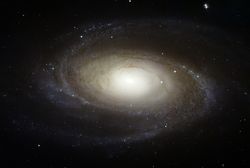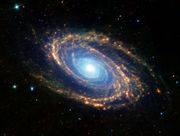Messier 81
 |
|
| A Hubble Space Telescope (HST) image of Messier 81. Credit: HST/NASA/ESA. |
|
| Observation data Epoch J2000 |
|
|---|---|
| Constellation | Ursa Major[3] |
| Right ascension | 09h 55m 33.2s [4] |
| Declination | +69° 3′ 55″[4] |
| Apparent dimension (V) | 26.9 × 14.1 moa [4] |
| Apparent magnitude (V) | 6.94[5][6] |
| Characteristics | |
| Type | SA(s)ab[4], LINER[4] |
| Astrometry | |
| Helio Radial velocity | -34 ± 4 [4]km/s |
| Redshift | -0.000113 ± 0.000013 [4] |
| Galactocentric Velocity | 73 ± 6 [4] km/s |
| Distance | 11.8 ± 0.4 Mly (3.6 ± 0.12 Mpc) |
| Other designations | |
Messier 81 (also known as NGC 3031 or Bode's Galaxy) is a spiral galaxy about 12 million light-years away in the constellation Ursa Major. M81 is one of the most striking examples of a grand design spiral galaxy, with near perfect arms spiraling into the very center. Because of its proximity to Earth, its large size, and its active galactic nucleus (which harbors a 70 million M☉ [8] supermassive black hole) Messier 81 is a popular galaxy to study in professional astronomy research. The galaxy's large size and relatively low apparent magnitude (lower magnitude implies higher brightness) also make it a popular target for amateur astronomy observations.[9]
Contents |
Discovery
Messier 81 was first discovered by Johann Elert Bode in 1774.[10] Consequently, the galaxy is sometimes referred to as "Bode's Galaxy". In 1779, Pierre Méchain and Charles Messier reidentified Bode's object, which was subsequently listed in the Messier Catalogue.[10]
Dust emission

Most of the emission at infrared wavelengths originates from interstellar dust.[12][13] This interstellar dust is found primarily within the galaxy's spiral arms, and it has been shown to be associated with star formation regions.[12][13] The general explanation is that the hot, short-lived blue stars that are found within star formation regions are very effective at heating the dust and hence enhancing the infrared dust emission from these regions.
Supernova
Only one supernova has been detected in Messier 81.[14] The supernova, named SN 1993J, was discovered on 28 March 1993 by F. Garcia in Spain.[15] At the time, it was the second brightest supernova observed in the twentieth century.[16] The spectral characteristics of the supernova changed over time. Initially, it looked more like a type II supernova (a supernovae formed by the explosion of a giant star) with strong hydrogen spectral line emission, but later the hydrogen lines faded and strong helium spectral lines appeared, making the supernova look more like a type Ib.[16][17] Moreover, the variations in SN 1993J's luminosity over time were not like the variations observed in other type II supernovae[18][19] but did resemble the variations observed in type Ib supernovae.[20] Hence, the supernova has been classified as a type IIb, a transitory class between type II and type Ib.[17] The scientific results from this supernova suggested that type Ib and Ic supernovae were actually formed through the explosions of giant stars through processes similar to what takes place in type II supernovae.[17][21] The supernova was also used to estimate a distance of 8.5 ± 1.3 Mly (2.6 ± 0.4 Mpc) to Messier 81.[16]
Nearby galaxies and galaxy group information

Messier 81 is the largest galaxy in the M81 Group, a group of 34 galaxies located in the constellation Ursa Major.[22] The distance from the Earth to the group is approximately 11.7 Mly (3.6 Mpc), making this one of the closest groups to the Local Group, which contains the Milky Way.[22]
M81 is gravitationally interacting with Messier 82 and NGC 3077.[23] The interactions have stripped some hydrogen gas away from all three galaxies, leading to the formation of filamentary gas structures in the group.[23] Moreover, the interactions have also caused some interstellar gas to fall into the centers of Messier 82 and NGC 3077, which has led to strong starburst activity (or the formation of many stars) within the centers of these two galaxies.[23]
Amateur astronomy information
Messier 81 is located approximately 10° northwest of Alpha Ursae Majoris along with several other galaxies in the Messier 81 Group.[9][24] Messier 81 and Messier 82 can both be viewed easily using binoculars and small telescopes.[24][9] The two objects are generally not observable to the unaided eye, although highly experienced amateur astronomers may be able to see Messier 81 under exceptional observing conditions.[9] Telescopes with apertures of 8 inches or larger are needed to distinguish structure in the galaxy.[24]
See also
- M81 in fiction (in the galaxies in fiction article)
- Bode's Galaxy
- Messier object
- List of Messier objects
- New General Catalogue
- List of galaxies
References
- ↑ Jensen, Joseph B.; Tonry, John L.; Barris, Brian J.; Thompson, Rodger I.; Liu, Michael C.; Rieke, Marcia J.; Ajhar, Edward A.; Blakeslee, John P. (February 2003). "Measuring Distances and Probing the Unresolved Stellar Populations of Galaxies Using Infrared Surface Brightness Fluctuations". Astrophysical Journal 583 (2): 712–726. doi:10.1086/345430. http://adsabs.harvard.edu/abs/2003ApJ...583..712J.
- ↑ I. D. Karachentsev, O. G. Kashibadze (2006). "Masses of the local group and of the M81 group estimated from distortions in the local velocity field". Astrophysics 49 (1): 3–18. doi:10.1007/s10511-006-0002-6. http://adsabs.harvard.edu/cgi-bin/nph-bib_query?bibcode=2006Ap.....49....3K.
- ↑ R. W. Sinnott, editor (1988). The Complete New General Catalogue and Index Catalogue of Nebulae and Star Clusters by J. L. E. Dreyer. Sky Publishing Corporation and Cambridge University Press. ISBN 0-933-34651-4.
- ↑ 4.00 4.01 4.02 4.03 4.04 4.05 4.06 4.07 4.08 4.09 4.10 "NASA/IPAC Extragalactic Database". Results for NGC 3031. http://nedwww.ipac.caltech.edu/. Retrieved 2006-11-10.
- ↑ "SIMBAD-M81". SIMBAD Astronomical Database. http://simbad.u-strasbg.fr/simbad/sim-id?Ident=M81. Retrieved 2009-11-28.
- ↑ Armando, Gil de Paz; Boissier; Madore; Seibert; Boselli; et al. (2007). "The GALEX Ultraviolet Atlas of Nearby Galaxies". Astrophysical Journal (ApJS) 173: 185–255. doi:10.1086/516636. http://arxiv.org/abs/astro-ph/0606440. Retrieved 2009-11-28.
- ↑ "SIMBAD Astronomical Database". Results for NGC 3031. http://simbad.u-strasbg.fr/Simbad. Retrieved 2006-11-10.
- ↑ N. Devereux, H. Ford, Z. Tsvetanov, and J. Jocoby (2003). "STIS Spectroscopy of the Central 10 Parsecs of M81: Evidence for a Massive Black Hole". Astronomical Journal 125: 1226–1235. doi:10.1086/367595. http://adsabs.harvard.edu/abs/2003AJ....125.1226D.
- ↑ 9.0 9.1 9.2 9.3 S. J. O'Meara (1998). The Messier Objects. Cambridge: Cambridge University. ISBN 0-521-55332-6.
- ↑ 10.0 10.1 K. G. Jones (1991). Messier's Nebulae and Star Clusters (2nd ed.). Cambridge: Cambridge University Press. ISBN 0-521-37079-5.
- ↑ 11.0 11.1 S. P. Willner, M. L. N. Ashby, P. Barmby, G. G. Fazio, M. Pahre, H. A. Smith, R. C. Kennicutt, Jr., D. Calzetti, D. A. Dale, B. T. Draine, M. W. Regan, S. Malhotra, M. D. Thornley, P. N. Appleton, D. Frayer, G. Helou, S. Stolovy, and L. Storrie-Lombardi (2004). "Infrared Array Camera (IRAC) Observations of M81". Astrophysical Journal Supplement Series 154: 222–228. doi:10.1086/422913. http://adsabs.harvard.edu/abs/2004ApJS..154..222W.
- ↑ 12.0 12.1 12.2 K. D. Gordon, P. G. Pérez-González, K. A. Misselt, E. J. Murphy, G. J. Bendo, F. Walter, M. D. Thornley, R. C. Kennicutt, Jr., G. H. Rieke, C. W. Engelbracht, J.-D. T. Smith, A. Alonso-Herrero, P. N. Appleton, D. Calzetti, D. A. Dale, B. T. Draine, D. T. Frayer, G. Helou, J. L. Hinz, D. C. Hines, D. M. Kelly, J. E. Morrison, J. Muzerolle, M. W. Regfan, J. A. Stansberry, S. R. Stolovy, L. J. Storrie-Lombardi, K. Y. L. Su, E. T. Young (2004). "Spatially Resolved Ultraviolet, Hα, Infrared, and Radio Star Formation in M81". Astrophysical Journal Supplement Series 154: 215–221. doi:10.1086/422714. http://adsabs.harvard.edu/abs/2004ApJS..154..215G.
- ↑ 13.0 13.1 P. G. Pérez-González, R. C. Kennicutt, Jr., K. D. Gordon, K. A. Misselt, A. Gil de Paz, C. W. Engelbracht, G. H. Rieke, G. J. Bendo, L. Bianchi, S. Bossier, D. Calzetti, D. A. Dale, B. T. Draine, T. H. Jarrett, D. Hollenbach, M. K. M. Prescott (2006). "Ultraviolet through Far-Infrared Spatially Resolved Analysis of the Recent Star Formation in M81 (NGC 3031)". Astrophysical Journal 648: 987–1006. doi:10.1086/506196. http://adsabs.harvard.edu/abs/2006ApJ...648..987P.
- ↑ "NASA/IPAC Extragalactic Database". Results for extended name search on NGC 3031. http://nedwww.ipac.caltech.edu/. Retrieved 2007-02-27.
- ↑ J. Ripero, F. Garcia, D. Rodriguez, P. Pujol, A. V. Filippenko, R. R. Treffers, Y. Paik, M. Davis, D. Schlegel, F. D. A. Hartwick, D. D. Balam, D. Zurek, R. M. Robb, P. Garnavich, B. A. Hong (1993). "Supernova 1993J in NGC 3031". IAU Circular 5731. http://adsabs.harvard.edu/abs/1993IAUC.5731....1R.
- ↑ 16.0 16.1 16.2 B. P. Schmidt, R. P. Kirshner, R. G. Eastman, R. Grashuis, I. dell'Antonio, N. Caldwell, C. Foltz, J. P. Huchra, A. A. E. Milone (1993). "The unusual supernova SN1993J in the galaxy M81". Nature 364: 600–602. doi:10.1038/364600a0. http://adsabs.harvard.edu/abs/1993Natur.364..600S.
- ↑ 17.0 17.1 17.2 A. V. Filippenko, T. Matheson, L. C. Ho (1993). "The "Type IIb" Supernova 1993J in M81: A Close Relative of Type Ib Supernovae". Astrophysical Journal Letters 415: L103–L106. doi:10.1086/187043. http://adsabs.harvard.edu/abs/1993ApJ...415L.103F.
- ↑ P. J. Benson, W. Herbst, J. J> Salzer, G. Vinton, G. J. Hanson, S. J. Ratcliff, P. F. Winkler, D. M. Elmegreen, F. Chromey, C. Strom, T. J. Balonek, B. G. Elmegreen (1994). "Light curves of SN 1993J from the Keck Northeast Astronomy Consortium". Astronomical Journal 107: 1453–1460. doi:10.1086/116958. http://adsabs.harvard.edu/abs/1994AJ....107.1453B.
- ↑ J. C. Wheeler, E. Barker, R. Benjamin, J. Boisseau, A. Clocchiatti, G. de Vaucouleurs, N. Gaffney, R. P. Harkness, A. M. Khokhlov, D. F. Lester, B. J> Smith, V. V. Smith, J. Tomkin (1993). "Early Observations of SN 1993J in M81 at McDonald Observatory". Astrophysical Journal 417: L71–L74. doi:10.1086/187097. http://adsabs.harvard.edu/abs/1993ApJ...417L..71W.
- ↑ M. W. Richmond, R. R. Treffers, A. V. Filippenko, Y. Palik, B. Leibundgut, E. Schulman, C. V. Cox (1994). "UBVRI photometry of SN 1993J in M81: The first 120 days". Astronomical Journal 107: 1022–1040. doi:10.1086/116915. http://adsabs.harvard.edu/abs/1994AJ....107.1022R.
- ↑ A. V. Filippenko, T. Matheson, A. J. Barth (1994). "The peculiar type II supernova 1993J in M81: Transition to the nebular phase". Astronomical Journal 108: 2220–2225. doi:10.1086/117234. http://adsabs.harvard.edu/abs/1994AJ....108.2220F.
- ↑ 22.0 22.1 I. D. Karachentsev (2005). "The Local Group and Other Neighboring Galaxy Groups". Astronomical Journal 129: 178–188. doi:10.1086/426368. http://adsabs.harvard.edu/abs/2005AJ....129..178K.
- ↑ 23.0 23.1 23.2 M. S. Yun, P. T. P. Ho, K. Y. Lo (1994). "A high-resolution image of atomic hydrogen in the M81 group of galaxies". Nature 372 (6506): 530–532. doi:10.1038/372530a0. PMID 7990925. http://adsabs.harvard.edu/abs/1994Natur.372..530Y.
- ↑ 24.0 24.1 24.2 D. J. Eicher (1988). The Universe from Your Backyard. Cambridge: Cambridge University Press. ISBN 0-521-36299-7.
External links
- M81, SEDS Messier pages
- SST: Messier 81
- APOD: Bright Galaxy M81 (6/20/02)
- NightSkyInfo.com - M81, Bode's Galaxy
- Messier 81 on WikiSky: DSS2, SDSS, GALEX, IRAS, Hydrogen α, X-Ray, Astrophoto, Sky Map, Articles and images
- ESA/Hubble images of M81
- Galaxy Messier 81 (Bode's Galaxy)
- Spitzer Image Gallery
- Helkit Observatory
- M81 imaged through a semiprofessional amateur-telescope
- Deep image of the M81 Area
Coordinates: ![]() 09h 55m 33.2s, +69° 03′ 55″
09h 55m 33.2s, +69° 03′ 55″
|
|||||||||||